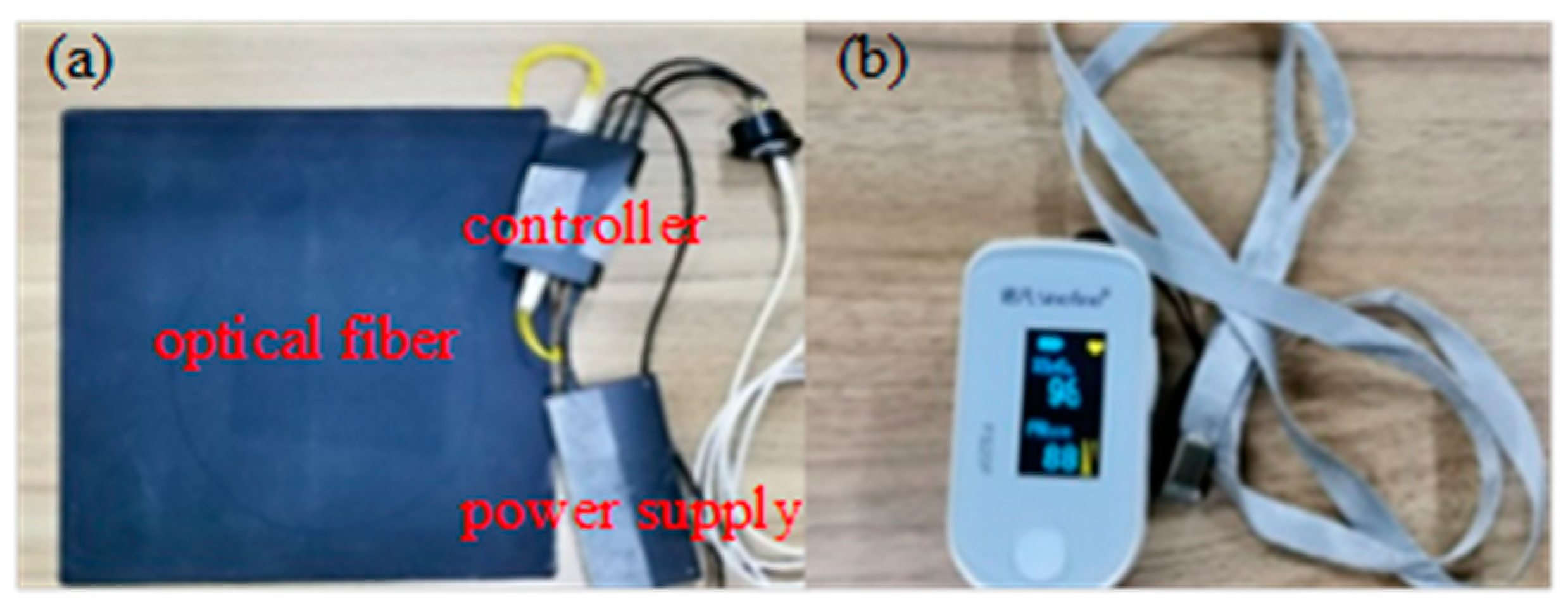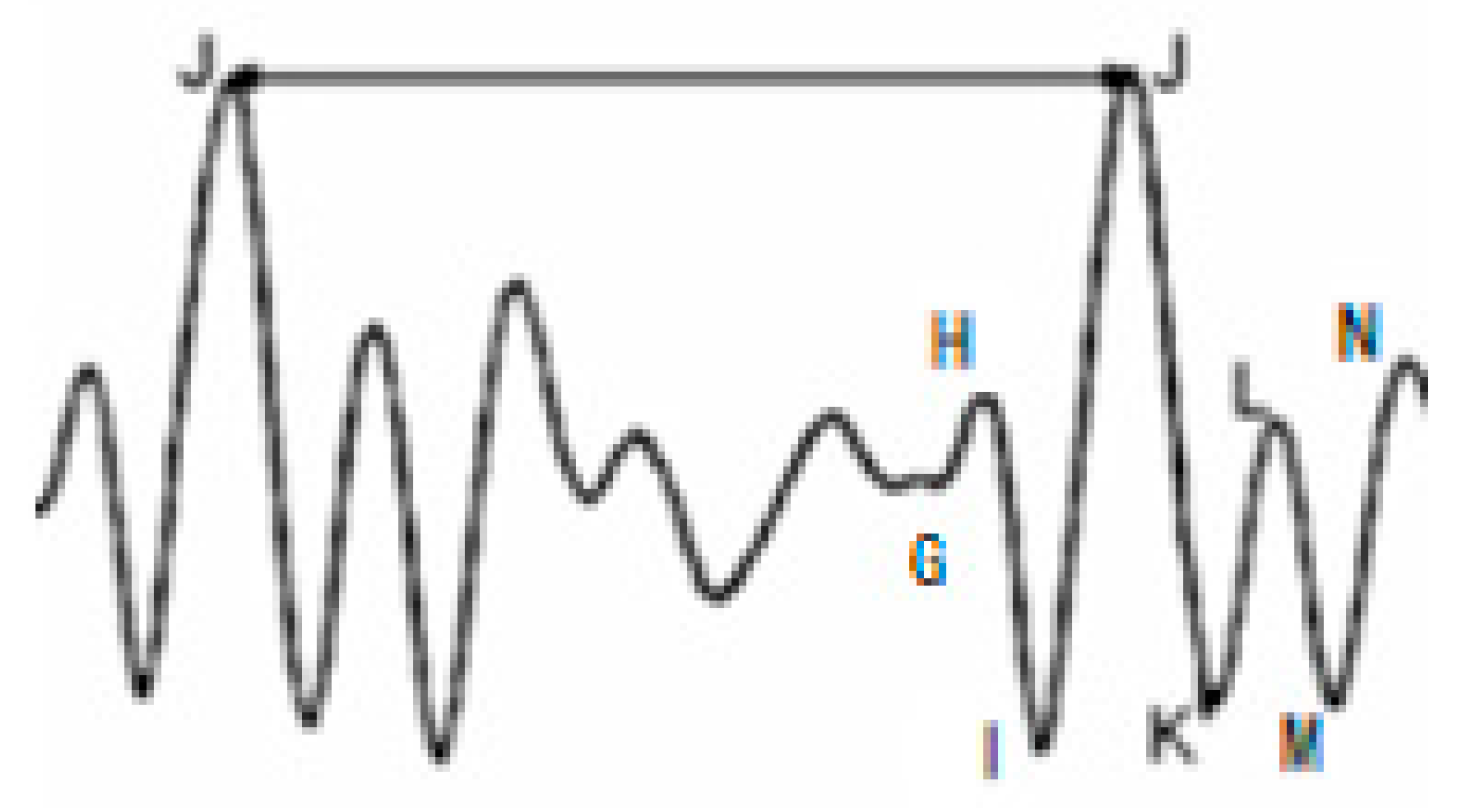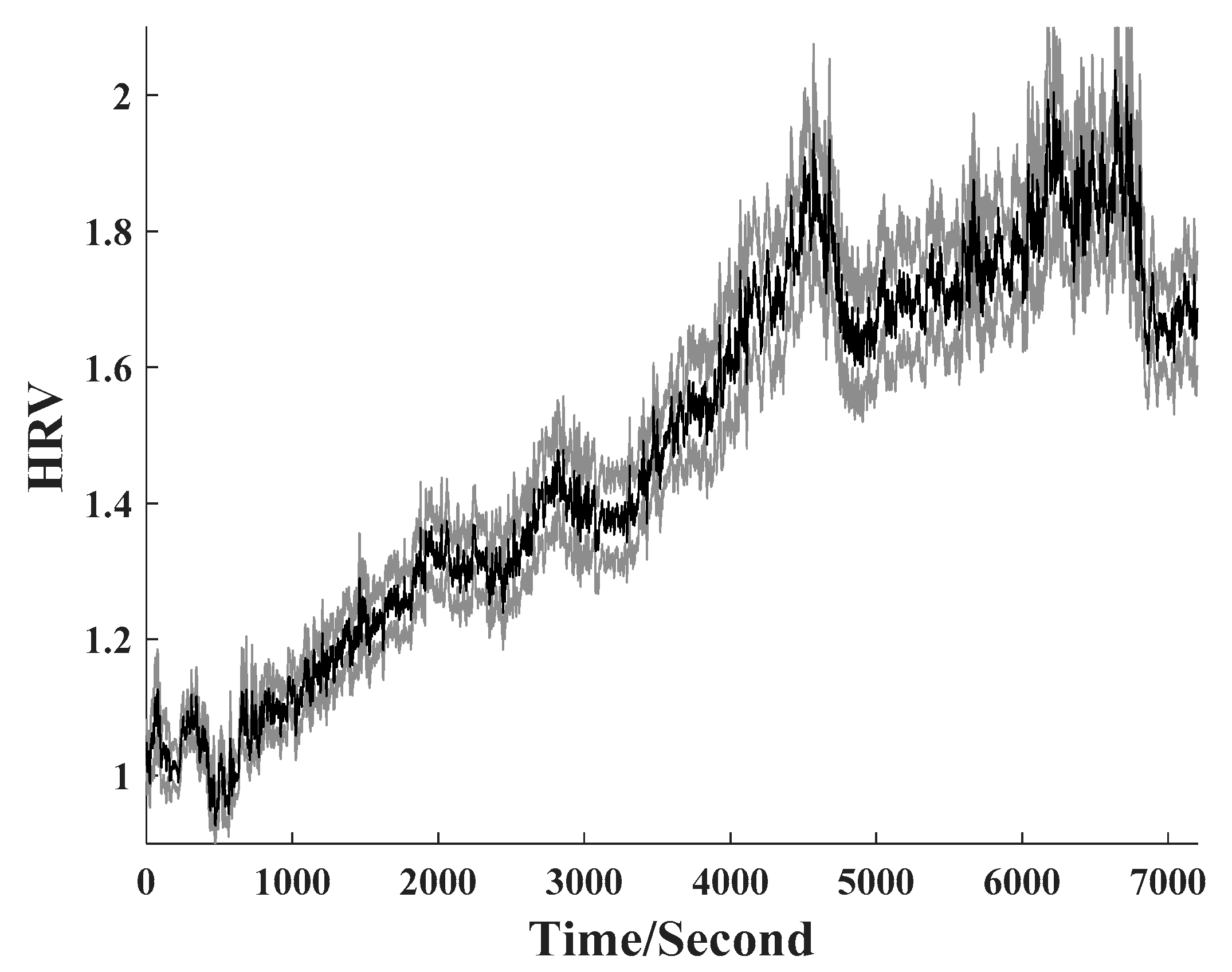A Practical Application for Quantitative Brain Fatigue Evaluation Based on Machine Learning and Ballistocardiogram
Abstract
:1. Introduction
2. Participants and Methods
2.1. Participants and Data Collections
2.2. Computation of Heart Rate and HRV from BCG Signal
2.3. Random Forest Model Construction
- (a)
- Form the training set and testing set from the original data set;
- (b)
- Randomly extract d features from the whole D features from the training samples (d < D);
- (c)
- Construct random forest classification model with multiple decision trees and input the training set with the extracted d features into each decision tree;
- (d)
- Enter testing set in the trained random forest model, each decision tree gets its own prediction result, then vote on the prediction result. It is judged that the category with the most votes is the final predicted result.
3. Results and Discussion
4. Conclusions
Author Contributions
Funding
Institutional Review Board Statement
Informed Consent Statement
Conflicts of Interest
References
- Li, G.; Huang, S.; Xu, W.; Jiao, W.; Jiang, Y.; Gao, Z.; Zhang, J. The impact of mental fatigue on brain activity: A comparative study both in resting state and task state using EEG. BMC Neurosci. 2020, 21, 20. [Google Scholar] [CrossRef] [PubMed]
- Wang, L.; Pei, Y. The impact of continuous driving time and rest time on commercial drivers’ driving performance and recovery. J. Saf. Res. 2014, 50, 11–15. [Google Scholar] [CrossRef] [PubMed]
- Jang, H.J.; Kim, O.; Kim, S.; Kim, M.S.; Choi, J.A.; Kim, B.; Dan, H.; Jung, H. Factors Affecting Physical and Mental Fatigue among Female Hospital Nurses: The Korea Nurses’ Health Study. Healthcare 2021, 9, 201. [Google Scholar] [CrossRef]
- Boulazreg, S.; Rokach, A. The Lonely, Isolating, and Alienating Implications of Myalgic Encephalomyelitis/Chronic Fatigue Syndrome. Healthcare 2020, 8, 413. [Google Scholar] [CrossRef] [PubMed]
- Fennell, P.; Dorr, N.; George, S. Elements of Suffering in Myalgic Encephalomyelitis/Chronic Fatigue Syndrome: The Experience of Loss, Grief, Stigma, and Trauma in the Severely and Very Severely Affected. Healthcare 2021, 9, 553. [Google Scholar] [CrossRef]
- Maksoud, R.; Eaton-Fitch, N.; Matula, M.; Cabanas, H.; Staines, D.; Marshall-Gradisnik, S. Systematic Review of Sleep Characteristics in Myalgic Encephalomyelitis/Chronic Fatigue Syndrome. Healthcare 2021, 9, 568. [Google Scholar] [CrossRef]
- Trejo, L.J.; Kubitz, K.; Rosipal, R.; Kochavi, R.L.; Montgomery, L.D. EEG-Based Estimation and Classification of Mental Fatigue. Psychology 2015, 6, 572–589. [Google Scholar] [CrossRef] [Green Version]
- Yang, S.; Wang, Z.; Wang, L.; Shi, B.; Peng, S. Research on the influence of mental fatigue on information resources allocation of working memory. Sheng Wu Yi Xue Gong Cheng Xue Za Zhi 2021, 38, 671–677. [Google Scholar]
- Wang, H.; Zhang, C.; Shi, T.; Wang, F.; Ma, S. Real-Time EEG-Based Detection of Fatigue Driving Danger for Accident Prediction. Int. J. Neural Syst. 2015, 25, 1550002. [Google Scholar] [CrossRef]
- Hu, X.; Lodewijks, G. Detecting fatigue in car drivers and aircraft pilots by using non-invasive measures: The value of differentiation of sleepiness and mental fatigue. J. Saf. Res. 2020, 72, 173–187. [Google Scholar] [CrossRef]
- Lin, L.; Huang, C.; Ni, X.; Wang, J.; Zhang, H.; Li, X.; Qian, Z. Driver fatigue detection based on eye state. Technol. Health Care 2015, 23, S453–S463. [Google Scholar] [CrossRef] [Green Version]
- Peng, Y.; Dong, Y.; Cheng, D. Design and Implementation of a Driver’s Eye State Recognition Algorithm Based on PERCLOS. Chin. J. Electron. 2014, 23, 669–672. [Google Scholar]
- Qi, P.; Ru, H.; Gao, L.; Zhang, X.; Zhou, T.; Tian, Y.; Thakor, N.; Bezerianos, A.; Li, J.; Sun, Y. Neural Mechanisms of Mental Fatigue Revisited: New Insights from the Brain Connectome. Engineering 2019, 5, 276–286. [Google Scholar] [CrossRef]
- Dimitrakopoulos, G.N.; Kakkos, I.; Dai, Z.; Wang, H.; Sgarbas, K.; Thakor, N.; Bezerianos, A.; Sun, Y. Functional connectivity analysis of mental fatigue reveals different network topological alterations between driving and vigilance tasks. IEEE Trans. Neural Syst. Rehabil. Eng. 2018, 26, 740–749. [Google Scholar] [CrossRef]
- Liu, X.; Li, G.; Wang, S.; Wan, F.; Sun, Y.; Wang, H.; Bezerianos, A.; Li, C.; Sun, Y. Toward practical driving fatigue detection using three frontal EEG channels: A proof-of-concept study. Physiol. Meas. 2021, 42, 044003. [Google Scholar] [CrossRef]
- Wu, C.; Wang, B.; Shen, G. Unobtrusive Monitoring of Sedentary Behaviors with Fusion of Bluetooth and Ballistocardiogram Signals. Methods 2021. [Google Scholar] [CrossRef] [PubMed]
- Jiao, C.; Su, B.-Y.; Lyons, P.; Zare, A.; Ho, D.K.; Skubic, M. Multiple Instance Dictionary Learning for Beat-to-Beat Heart Rate Monitoring from Ballistocardiograms. IEEE Trans. Biomed. Eng. 2018, 65, 2634–2648. [Google Scholar] [CrossRef] [Green Version]
- Seok, W.; Lee, K.; Cho, D.; Roh, J.; Kim, S. Blood Pressure Monitoring System Using a Two-Channel Ballistocardiogram and Convolutional Neural Networks. Sensors 2021, 21, 2303. [Google Scholar] [CrossRef] [PubMed]
- Wang, L.; Geng, S.; Liu, B.; Jin, Y. Ballistocardiogram heart rate detection: Improved methodology based on a three-layer filter. Measurement 2019, 149, 106956. [Google Scholar] [CrossRef]
- Chen, W.; Zhang, Y.; Yang, H.; Qiu, Y.; Li, H.; Chena, Z.; Yu, C. Non-invasive Measurement of Vital Signs Based on Seven-core Fiber Interferometer. IEEE Sens. J. 2021, 21, 10703–10710. [Google Scholar] [CrossRef]
- Wang, K.; Zhu, T.; Zhang, X.; Yu, C.; Cao, X.; Jintian, T. Comparison of heart rate variability between ballistocardiogram and electrocardiogram. Chin. J. Cardiol. 2015, 43, 448–451. [Google Scholar]
- Ahn, S.; Nguyen, T.; Jang, H.; Kim, J.G.; Jun, S.C. Exploring Neuro-Physiological Correlates of Drivers’ Mental Fatigue Caused by Sleep Deprivation Using Simultaneous EEG, ECG, and fNIRS Data. Front. Hum. Neurosci. 2016, 10, 219. [Google Scholar] [CrossRef] [PubMed]
- Fu, R.; Wang, H. Detection of driving fatigue by using noncontact EMG and ECG signals measurement system. Int. J. Neural Syst. 2014, 24, 1450006. [Google Scholar] [CrossRef] [PubMed]
- Murugan, S.; Selvaraj, J.; Sahayadhas, A. Detection and analysis: Driver state with electrocardiogram (ECG). Phys. Eng. Sci. Med. 2020, 43, 525–537. [Google Scholar] [CrossRef]
- Wang, L.; Wang, H.; Jiang, X. A New Method to Detect Driver Fatigue Based on EMG and ECG Collected by Portable Non-Contact Sensors. Promet Traffic Transp. 2017, 29, 479–488. [Google Scholar] [CrossRef] [Green Version]
- Wang, F.; Wang, H.; Fu, R. Real-Time ECG-Based Detection of Fatigue Driving Using Sample Entropy. Entropy 2018, 20, 196. [Google Scholar] [CrossRef] [Green Version]
- Mehta, R.K.; Agnew, M.J. Influence of mental workload on muscle endurance, fatigue, and recovery during intermittent static work. Graefes Arch. Clin. Exp. Ophthalmol. 2012, 112, 2891–2902. [Google Scholar] [CrossRef] [PubMed]
- Mehta, R.K.; Nuamah, J. Relationship between Acute Physical Fatigue and Cognitive Function During Orthostatic Challenge in Men and Women: A Neuroergonomics Investigation. Hum. Factors J. Hum. Factors Ergon. Soc. 2020. [Google Scholar] [CrossRef]
- Stewart, C.C.; Wright, R.A.; Hui, S.-K.A.; Simmons, A. Outcome expectancy as a moderator of mental fatigue influence on cardiovascular response. Psychophysiology 2009, 46, 1141–1149. [Google Scholar] [CrossRef] [PubMed]
- LaGory, J.; Dearen, B.B.; Tebo, K.; Wright, R.A. Reported fatigue, difficulty, and cardiovascular response to an auditory mental arithmetic challenge. Int. J. Psychophysiol. 2011, 81, 91–98. [Google Scholar] [CrossRef]
- Li, G.; Li, B.; Wang, G.; Zhang, J.; Wang, J. A New Method for Human Mental Fatigue Detection with Several EEG Channels. J. Med. Biol. Eng. 2017, 37, 240–247. [Google Scholar] [CrossRef]
- Li, G.; Luo, Y.; Zhang, Z.; Xu, Y.; Jiao, W.; Jiang, Y.; Huang, S.; Wang, C. Effects of Mental Fatigue on Small-World Brain Functional Network Organization. Neural Plast. 2019, 2019, 1716074. [Google Scholar] [CrossRef] [PubMed] [Green Version]
- Delliaux, S.; Delaforge, A.; Deharo, J.-C.; Chaumet, G. Mental Workload Alters Heart Rate Variability, Lowering Non-linear Dynamics. Front. Physiol. 2019, 10, 565. [Google Scholar] [CrossRef] [PubMed] [Green Version]
- Joyce, D.; Barrett, M. State of the science: Heart rate variability in health and disease. BMJ Support. Palliat. Care 2018, 9, 274–276. [Google Scholar] [CrossRef]
- Breiman, L. Random forests. Mach. Learn. 2001, 45, 5–32. [Google Scholar] [CrossRef] [Green Version]
- Laurent, F.; Valderrama, M.; Besserve, M.; Guillard, M.; Lachaux, J.-P.; Martinerie, J.; Florence, G. Multimodal information improves the rapid detection of mental fatigue. Biomed. Signal Process. Control 2013, 8, 400–408. [Google Scholar] [CrossRef]
- Ding, Y.; Cao, Y.; Duffy, V.G.; Wang, Y.; Zhang, X.; Xuefeng, Z. Measurement and identification of mental workload during simulated computer tasks with multimodal methods and machine learning. Ergonomics 2020, 63, 896–908. [Google Scholar] [CrossRef] [PubMed]




| Methods | Descriptions | Characters |
|---|---|---|
| Subjective evaluation [10] | Pearson Fatigue Scale, Stanford Sleepiness Scale, questionnaire survey, interview, etc. | Reliability and validity are low; they are often used as auxiliary research methods |
| Psychological indicators [14] | Sound and light response time, flash fusion frequency, etc. | Require additional design of mission experiments and equipment,; they are often used as auxiliary research methods |
| Facial features [11,12] | Percentage of eyelid closure, blink frequency, nodding frequency, yawn frequency, mouth state, etc. | No human contact, have strong practicability, but are easily affected by internal and external environments |
| Biomedical signals [13,14] | EEG, ECG, EMG, blood oxygen signal, respiratory signal, etc. | Often have touch with the human and have high accuracy and reliability |
| Subject Number | Heart Rate from Fiber Optic Sensor | Heart Rate from Medical Monitor | Absolute Error Value |
|---|---|---|---|
| 1 | 76 | 78 | 2 |
| 2 | 82 | 81 | 1 |
| 3 | 80 | 83 | 3 |
| 4 | 76 | 75 | 1 |
| 5 | 85 | 86 | 1 |
| 6 | 83 | 85 | 2 |
| 7 | 80 | 80 | 0 |
| 8 | 81 | 82 | 1 |
| 9 | 77 | 79 | 2 |
| 10 | 94 | 93 | 1 |
| 11 | 81 | 83 | 2 |
| 12 | 78 | 78 | 0 |
| 13 | 83 | 85 | 2 |
| 14 | 77 | 78 | 1 |
| 15 | 75 | 75 | 0 |
| 16 | 78 | 79 | 1 |
| 17 | 96 | 96 | 0 |
| 18 | 87 | 89 | 2 |
| 19 | 78 | 81 | 3 |
| 20 | 78 | 79 | 1 |
| Time (min) | 10–20 | 20–30 | 30–40 | 40–50 | 50–60 | 60–70 | 70–80 | 80–90 | 90–100 | 100–110 | 110–120 |
|---|---|---|---|---|---|---|---|---|---|---|---|
| Accuracy (%) | 72.30 | 79.08 | 81.15 | 82.09 | 87.72 | 91.41 | 94.43 | 95.13 | 96.18 | 96.54 | 94.98 |
Publisher’s Note: MDPI stays neutral with regard to jurisdictional claims in published maps and institutional affiliations. |
© 2021 by the authors. Licensee MDPI, Basel, Switzerland. This article is an open access article distributed under the terms and conditions of the Creative Commons Attribution (CC BY) license (https://creativecommons.org/licenses/by/4.0/).
Share and Cite
Xu, Y.; Yang, Z.; Li, G.; Tian, J.; Jiang, Y. A Practical Application for Quantitative Brain Fatigue Evaluation Based on Machine Learning and Ballistocardiogram. Healthcare 2021, 9, 1453. https://doi.org/10.3390/healthcare9111453
Xu Y, Yang Z, Li G, Tian J, Jiang Y. A Practical Application for Quantitative Brain Fatigue Evaluation Based on Machine Learning and Ballistocardiogram. Healthcare. 2021; 9(11):1453. https://doi.org/10.3390/healthcare9111453
Chicago/Turabian StyleXu, Yanting, Zhengyuan Yang, Gang Li, Jinghong Tian, and Yonghua Jiang. 2021. "A Practical Application for Quantitative Brain Fatigue Evaluation Based on Machine Learning and Ballistocardiogram" Healthcare 9, no. 11: 1453. https://doi.org/10.3390/healthcare9111453
APA StyleXu, Y., Yang, Z., Li, G., Tian, J., & Jiang, Y. (2021). A Practical Application for Quantitative Brain Fatigue Evaluation Based on Machine Learning and Ballistocardiogram. Healthcare, 9(11), 1453. https://doi.org/10.3390/healthcare9111453






